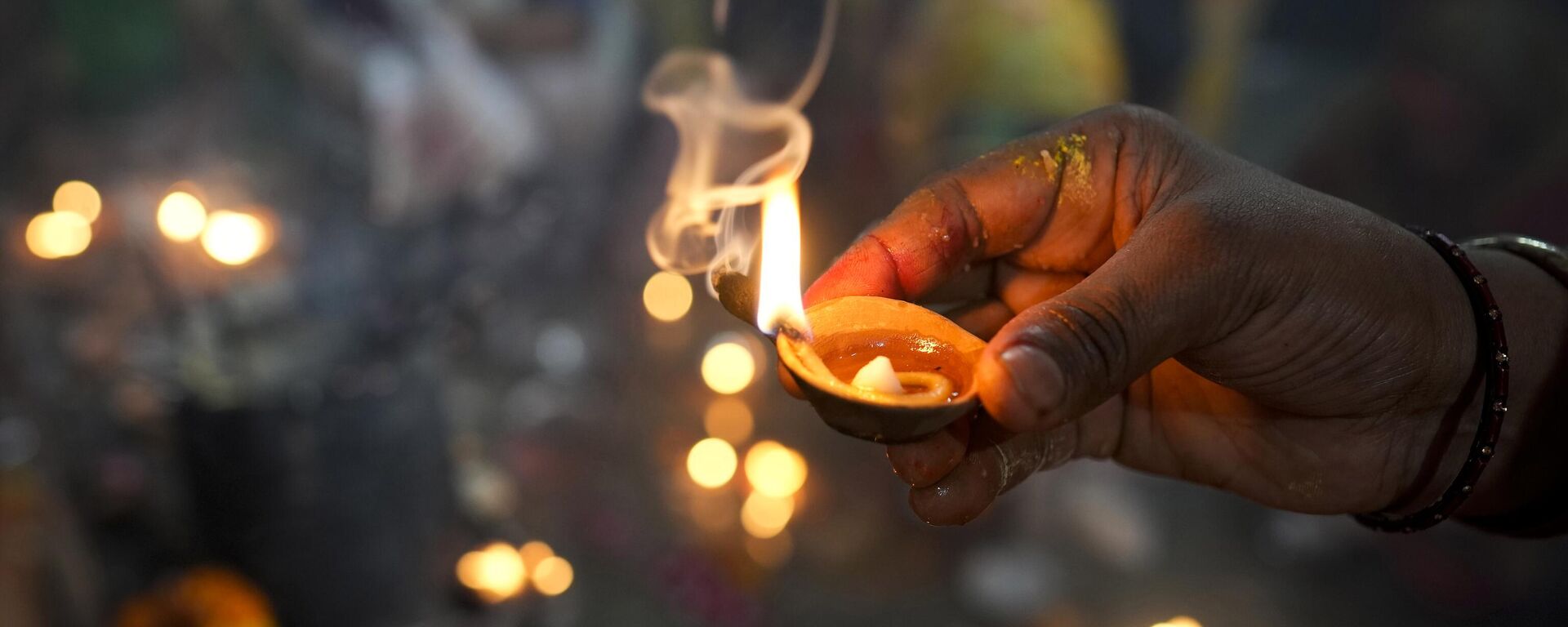https://sputniknews.in/20231023/why-is-dussehra-celebrated-after-navratri-4903914.html
Why is Dussehra Celebrated After Navratri?
Why is Dussehra Celebrated After Navratri?
Sputnik India
The nine-day festival of Navratri, which marks the worship of nine divine incarnations of Hindu Goddess Durga, culminates with Dussehra or Vijaya Dashami festival on the tenth day.
2023-10-23T21:09+0530
2023-10-23T21:09+0530
2023-10-23T21:09+0530
india
hindu
hindu deities
hindu goddess kali
hindu devotees
hindu festival
hindu shrine
hindutva
hinduism
navratri
https://cdn1.img.sputniknews.in/img/07e7/0a/17/5031868_0:160:3072:1888_1920x0_80_0_0_5cc2b5ee5111f5d60129076aa45437d5.jpg
The countdown for the highly anticipated Indian festival 'Dussehra' has begun, as devotees from around the globe come together to celebrate the Navratri festivities of worshipping nine divine incarnations of Goddess Durga for nine nights.The festival of Dussehra, Durga Puja or Vijaya Dashami marks the celebration of the victory of good over evil. It is celebrated with much fanfare in different manners across different regions of India.While Dussehra is celebrated in North India, Vijaya Dashami is celebrated in South India and the Bengali community celebrate Durga Puja.What is Dussehra?Dussehra, comes from two words - 'dasha' meaning ten heads of Ravana and 'hara' meaning defeat.The festival commemorates Lord Ram's glorious victory over the ten-headed demon king Ravana, who had kidnapped his wife, the goddess Sita, sparking an epic battle.According to Indian mythology, each of Ravana's heads represented a different nature or emotion. These include kama (sexual desire), bhaye (fear), moha (attachment), ahankar (ego), lobha (greed), jaddata (callousness), mada (pride), ghrina (hatred), krodha (anger) and irshya (envy).On Dussehra, people not only celebrate the triumph of Lord Ram but also try to overcome every negative situation and emotion by virtue of their benevolent nature.Durga Puja begins on the sixth day of Navratri, signifying the glorious victory of Goddess Durga over the formidable 'buffalo demon' Mahishasura, whose evil actions had brought the world into absolute chaos and destruction.Why Dussehra is Celebrated After Navratri?Dussehra is celebrated after the nine-day festival of Navratri because it has immense significance in Hindu mythology, signifying the glorious triumph of Lord Ram over the demon king Ravana of Lanka.According to legend, Lord Ram prayed to Goddess Durga before going on a war to rescue Goddess Sita from the clutches of Ravana.Devotees in North India and across the country commemorate Dussehra with great fervour as they symbolically ignite the embodiment of evil by burning effigies of Ravana along with his younger brother Kumbhakarana and powerful warrior son Meghanada.The celebration is further enhanced by the explosive display of firecrackers, an awe-inspiring spectacle of the festival. Durga Puja, on the other hand, is symbolic of Goddess Durga's victory over the demon king Mahishasura.The people of West Bengal and the Bengali community mark the grand finale of the festival before immersing the idol of Goddess Durga in water (visarjan ceremony) to bid her farewell.
https://sputniknews.in/20230927/navratri-nine-avatars-of-goddess-durga-worshipped-during-festival-4451765.html
india
Sputnik India
feedback.hindi@sputniknews.com
+74956456601
MIA „Rossiya Segodnya“
2023
Sangeeta Yadav
https://cdn1.img.sputniknews.in/img/07e6/0c/0f/110602_0:0:641:640_100x100_80_0_0_c298016a79eb02ef8caa9d1f688c12a5.jpg
Sangeeta Yadav
https://cdn1.img.sputniknews.in/img/07e6/0c/0f/110602_0:0:641:640_100x100_80_0_0_c298016a79eb02ef8caa9d1f688c12a5.jpg
News
en_IN
Sputnik India
feedback.hindi@sputniknews.com
+74956456601
MIA „Rossiya Segodnya“
The Illumination at Delhi's famous Jhandewalan Temple on the last day of nine-day Navratri festival dedicated to Hindu Goddess Durga.
Sputnik India
The Illumination at Delhi's famous Jhandewalan Temple on the last day of nine-day Navratri festival dedicated to Hindu Goddess Durga.
2023-10-23T21:09+0530
true
PT0M21S
Sputnik India
feedback.hindi@sputniknews.com
+74956456601
MIA „Rossiya Segodnya“
Sangeeta Yadav
https://cdn1.img.sputniknews.in/img/07e6/0c/0f/110602_0:0:641:640_100x100_80_0_0_c298016a79eb02ef8caa9d1f688c12a5.jpg
dussehra wishes, vijaya dashami festival wishes, how to play garba, tutiroal for beginners to play garba, what is garba, what is the significance of garba, garba and dandiya dance, garba night, dandiya night, navratri 2023, navratri, navratri 2023 march, navratri colours, happy navratri, chaitra navratri 2023, navratri 2023 date, navratri march 2023, navratri kab hai, navratri image, navratri colour, navratri wishes, navratri 2023 march date, navratri kab se hai, happy navratri wishes, navratri wishes in hindi, goddess durga, incarnations, vijaydashmi, dussehra festival, lord rama, ravana, why is 'navratri' celebrated?power of womanhood, chaitra navratri, sharada navratre, devotees worship, goddess shailaputri, goddess brahmacharini, goddess chandraghanta, goddess kushmanda, goddess skandamata, goddess katyayani, goddess kaalaratri, goddess mahagauri, goddess siddhidatri, shubh mahurat, how is navratri celebrated?temples, durga puja pandals, worshipping idols of goddess durga, navratri colors, dhunuchi dance, folk dance garba, dandiya, fast during navratri, fasting during navratri, navratra special vegetarian, navratri recipes, hindu festival, navratri, sanskrit, nine nights, devotees, worship, divine incarnations of goddess durga, hindu devotees, orange, first day of navratri, goddess shailputri, second day of navratri, white, goddess brahmacharini, goddess parvati, third day of navratri, red, goddess chandraghanta, fourth day of navratri, royal blue, goddess kushmanda, fifth day of navratri, yellow, goddess skandmata, lord skanda, lord kartikeya, lord murugan, sixth day of navratri, goddess mahagauri, seventh day of navratri, grey, seventh day of navratri, goddess kalratri, goddess shubankari, eighth day of navratri, purple, goddess mahagauri, ninth day of navratri, peacock green, goddess siddhidatri, vijaydashmi, dussehra festival, lord rama, king ravana, goddess sita, garba rules
dussehra wishes, vijaya dashami festival wishes, how to play garba, tutiroal for beginners to play garba, what is garba, what is the significance of garba, garba and dandiya dance, garba night, dandiya night, navratri 2023, navratri, navratri 2023 march, navratri colours, happy navratri, chaitra navratri 2023, navratri 2023 date, navratri march 2023, navratri kab hai, navratri image, navratri colour, navratri wishes, navratri 2023 march date, navratri kab se hai, happy navratri wishes, navratri wishes in hindi, goddess durga, incarnations, vijaydashmi, dussehra festival, lord rama, ravana, why is 'navratri' celebrated?power of womanhood, chaitra navratri, sharada navratre, devotees worship, goddess shailaputri, goddess brahmacharini, goddess chandraghanta, goddess kushmanda, goddess skandamata, goddess katyayani, goddess kaalaratri, goddess mahagauri, goddess siddhidatri, shubh mahurat, how is navratri celebrated?temples, durga puja pandals, worshipping idols of goddess durga, navratri colors, dhunuchi dance, folk dance garba, dandiya, fast during navratri, fasting during navratri, navratra special vegetarian, navratri recipes, hindu festival, navratri, sanskrit, nine nights, devotees, worship, divine incarnations of goddess durga, hindu devotees, orange, first day of navratri, goddess shailputri, second day of navratri, white, goddess brahmacharini, goddess parvati, third day of navratri, red, goddess chandraghanta, fourth day of navratri, royal blue, goddess kushmanda, fifth day of navratri, yellow, goddess skandmata, lord skanda, lord kartikeya, lord murugan, sixth day of navratri, goddess mahagauri, seventh day of navratri, grey, seventh day of navratri, goddess kalratri, goddess shubankari, eighth day of navratri, purple, goddess mahagauri, ninth day of navratri, peacock green, goddess siddhidatri, vijaydashmi, dussehra festival, lord rama, king ravana, goddess sita, garba rules
The countdown for the highly anticipated Indian festival 'Dussehra' has begun, as devotees from around the globe come together to celebrate the Navratri festivities of worshipping nine divine incarnations of Goddess Durga for nine nights.
The festival of Dussehra, Durga Puja or Vijaya Dashami marks the celebration of the victory of good over evil.
It is celebrated with much fanfare in different manners across different regions of India.
While Dussehra is celebrated in North India, Vijaya Dashami is celebrated in South India and the Bengali community celebrate Durga Puja.
Dussehra, comes from two words - 'dasha' meaning ten heads of Ravana and 'hara' meaning defeat.
The festival commemorates Lord Ram's glorious victory over the ten-headed demon king Ravana, who had kidnapped his wife, the goddess Sita, sparking an epic battle.
According to
Indian mythology, each of Ravana's heads represented a different nature or emotion.
These include kama (sexual desire), bhaye (fear), moha (attachment), ahankar (ego), lobha (greed), jaddata (callousness), mada (pride), ghrina (hatred), krodha (anger) and irshya (envy).
On Dussehra, people not only celebrate the triumph of Lord Ram but also try to overcome every negative situation and emotion by virtue of their benevolent nature.
Durga Puja begins on the sixth day of Navratri, signifying the
glorious victory of Goddess Durga over the formidable 'buffalo demon' Mahishasura, whose evil actions had brought the world into absolute chaos and destruction.
Why Dussehra is Celebrated After Navratri?
Dussehra is celebrated after the nine-day festival of Navratri because it has immense significance in Hindu mythology, signifying the glorious triumph of Lord Ram over the demon king Ravana of Lanka.
According to legend, Lord Ram prayed to Goddess Durga before going on a war to rescue Goddess Sita from the clutches of Ravana.
Devotees in North India and across the country commemorate Dussehra with great fervour as they symbolically ignite the embodiment of evil by burning effigies of Ravana along with his younger brother Kumbhakarana and powerful warrior son Meghanada.
The celebration is further enhanced by the explosive display of firecrackers, an awe-inspiring spectacle of the festival. Durga Puja, on the other hand, is symbolic of Goddess Durga's victory over the demon king Mahishasura.
The people of West Bengal and the Bengali community mark the grand finale of the festival before immersing the idol of Goddess Durga in water (visarjan ceremony) to bid her farewell.



